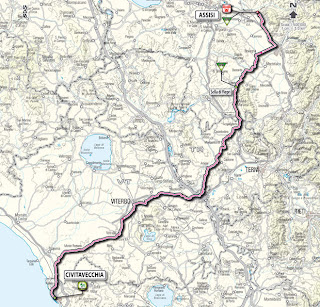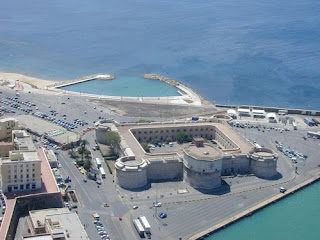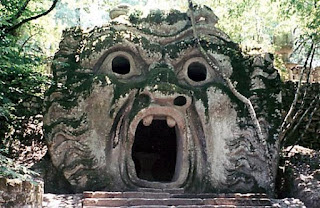The 95th Giro d'Italia, a grueling 3476.4km cycle, second only to the tour de France in prestige, is almost upon us. Now's the time to book hotels and plan your viewing. As is common with the big tours, the first few stages will take place in a different country. This year, for the first time, it's Denmark's turn, with stages 1-3 kicking off the tour on the 1st-3rd May. After a time trial around the fair city of Verona (where we lay our scene), the tour starts in earnest. Here's a map of the course, courtesy of La Gazzetta dello Sport.

|
The course changes every year. Last year, there was a great stage through Lazio (check out my previous Giro d'Italia post for details), taking in some beautiful scenery and really traversing the length of land. This year, they've gone for a different course, setting off from the cruise ship port of Civitavecchia and heading into northern Lazio (past all the hazelnut groves). They skirt the ancient city of Viterbo and pass through into neighboring Umbria, which, even though it's not Lazio, contains some absolutely stunning scenery (not to mention food). Finally, after 187km, the stage ends in Assisi, birthplace of St. Francis.

|
| A PDF of the route can be found here. |
Civitavecchia is about 80km north-west of Rome and is often the entry point for tourists to Italy, with connections to Sardinia, Sicily, Malta, Tunis and Barcelona. Civitavecchia is connected to Rome via rail and SS1, also known as Via Aurelia. It takes about 90mins to get to Rome but this is heavily dependent on the traffic so plan ahead if you want to be there on race day. Civitavecchia, despite it's name (meaning ancient town) doesn't have a great many sights, but does have enough to fill an afternoon.
There is the massive Forte Michelangelo, part-designed by Michelangelo and completed by Antonio da Sangallo the Younger, which like many fortresses built by da Sangallo, is of octagonal shape. There is also a castle, re-built in the late 15th century. Just north of the city are the hot sulphur Terme Taurine baths and, in pleasingly serendipitous fashion, Civitavecchia also houses a cathedral dedicated to San Francesco d'Assisi.

|
| Courtesy of Scolore. |
There is the massive Forte Michelangelo, part-designed by Michelangelo and completed by Antonio da Sangallo the Younger, which like many fortresses built by da Sangallo, is of octagonal shape. There is also a castle, re-built in the late 15th century. Just north of the city are the hot sulphur Terme Taurine baths and, in pleasingly serendipitous fashion, Civitavecchia also houses a cathedral dedicated to San Francesco d'Assisi.
After Civitavecchia, the route winds up through the Province of Viterbo (click here for all my posts on things to do in this province, such as going to lago di Vico or Forte Sangallo in Civita Castellana, built by the same da Sangallo who made the Forte Michelangelo), through the ancient town of Vetralla (where Mary Jane Cryan and her excellent blog reside) to Viterbo itself. Viterbo is an ancient papal city dating from the eighth century, when it was known as Castrum Viterbii (Castle of Viterbo). The historic center is one of the best preserved medieval towns of central Italy. There are two main sites to visit in Viterbo, the Papal Palace (Palazzo dei Papi) and the cathedral (Cattedrale di San Lorenzo).
Viterbo was once a papal home, from 1257 to 1281. The Papal Curia was moved there from Rome by Alexander IV, due to the constant urban violence within Rome and local political disaffection. The massive palace façade, facing the central square, Piazza di San Lorenzo which is dominated by the cathedral, is approached by a wide staircase completed in 1267. This is the place where hundreds of locals get their wedding photos done, and is a great place to stop for views and to breathe in the history of the place.
The cathedral was, according to legend, built on the site of an Etruscan temple of Hercules and although this can not be verified, Etruscan and Roman foundations can be seen on several of the buildings which make up the where the cathedral is situated, just across from the Papal Palace. Viterbo itself is a lovely city, filled with pasticcerie, leather goods shops (handbags and belts are the big sellers in Viterbo apparently), and the like. The older sections of the town (such as San Pellegrino) have lovely winding narrow streets that seem completely anachronistic, apart from the blaring TVs and scooters. There are also plenty of little restaurants and trattorie hidden away, making Viterbo a good place from which to explore the surrounding area.
Viterbo is approximately 80km (50 miles) north of Rome on the Via Cassia (SS2), with the drive taking about 90 minutes. The city can be reached by Cotral buses from Rome, which leave from Saxa Rubra. Trains are roughly every hour from Stazione Ostiense in Rome, and stop at Viterbo Porta Romana station, outside the Porta Romana (Roman Gateway) in the city walls. The journey by train takes nearly two hours. And finally, for more information on Viterbo you can check out my post, and/or the tourist information site for Viterbo and the surrounding area.
After Viterbo, the cyclists will travel past the surreal gardens of Bomarzo and the town of Soriano nel Cimino (home of the excellent chestnut festival), passing Orte, before crossing the Autostrada del Sole into the neighboring region of Umbria.
Once in Umbria, the route gets more mountainous as the riders cycle up past the lovely hilltop town of Narni (which I'll write a post about one day) to Acquasparta, past Montefalco (home of some excellent wines), and finally ends in Assisi. Quite a journey! Even if you do end up following them by car ;-)
P.S. If you are traveling around Lazio with public transport, make sure you check out my post on the BIRG travelcard, giving unlimited travel through various zones of Lazio.
*All maps taken from Gazzetta dello sport.
Viterbo photo from here.
Bomarzo photo from here.

